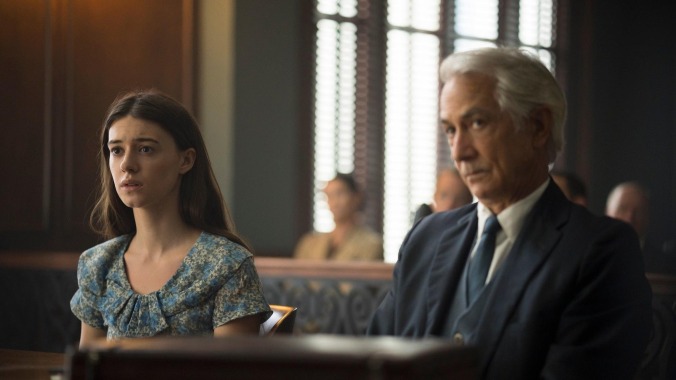Where The Crawdads Sing boils up a tasty beach-read gumbo
Daisy Edgar-Jones shines in Olivia Newman's adaptation of the best seller, which binds a lonely young woman's love story to a legal potboiler
Film Reviews Where the Crawdads Sing
The task for director Olivia Newman and writer Lucy Alibar with their adaptation of Where The Crawdads Sing, like with many book club darlings that came before it, was to recreate as faithfully as possible Delia Owens’ 2018 novel—regardless of what improvements or deviations might be warranted for a different medium. By that standard, Newman’s film is a success: it’s as faithful an adaptation as could likely be managed, warts and all. But beyond the baseline proficiency in its filmmaking, the warts feel most worthy of discussion, even if they don’t diminish the original qualities that made Owens’ source material a best seller.
In the Carolina marshes of the 1960s, police discover the body of Chase Andrews (Harris Dickinson), purported lover of the locally reviled “Marsh Girl,” Catherine “Kya” Clark (Daisy Edgar-Jones). When Kya is arrested and charged with Chase’s murder, she must rely on the generosity of local defense attorney Tom Milton (David Strathairn) to combat the rumormongering that has followed her throughout her life—at least enough to convince a jury that she is innocent of a crime for which there is little credible evidence against her. While Milton struggles to understand Kya, she recounts the story of her life.
The film is at its best during these ostensible flashbacks, weaving a tale of loneliness and a lifelong sense of betrayal that would be compelling even without the murder that theoretically drives the plot. Daisy Edgar-Jones, with movie star magnetism, plays Kya as strong by necessity, but also wounded deeply by a sense of abandonment after her older siblings and mother (Ahna O’Reilly) left her alone with the domineering force of her abusive father (Garret Dillahunt). Growing into young womanhood with only local shopkeepers Jumpin (Sterling Macer Jr.) and Mabel (Michael Hyatt) willing to assist her, Kya learns to survive on her own in the natural world of the marsh, until the lure of a childhood companion, Tate (Taylor John Smith), tests her willingness to open herself up to the possibility of being hurt yet again.
This makes for a compelling character study, albeit one informed primarily by a sense of isolation that the film’s brisk pace and courtroom framing device never authentically creates. However, for as much as we spend time with the rest of the cast, the performances they give are perfectly suited to the material. Taylor John Smith and Harris Dickinson broadly capture the diametrically opposed romantic influences in Kya’s life, drawing a thematic line between the necessity of loving someone even though they may hurt you, and the tragedy of loving someone despite the pain they willfully cause you. It’s the adult reinterpretation of the classic love triangle into a commentary on cycles of abuse, which was always the most potent component of Owens’ novel.
The standout supporting performances, however, are Sterling Macer Jr. and Michael Hyatt, whose characters walk a fine line in portraying humble Black shopkeepers while working to coyly undermine any white person who would threaten to hurt their or Kya’s livelihood. For characters that exist almost entirely to provide an explanation for why a 6-year-old didn’t die in the wilderness for lack of resources, they exemplify Black survival against the prejudices of the time. The unfortunate side effect is that the narrative paints a false equivalence between the discrimination they face and the discrimination Kya faces, simply through their juxtaposition, creating a dimension to the story that feels racially insensitive on screen—as it did on the page.
The weakest link in the cinematic adaptation is the courtroom procedural that feels crowbarred between bits of Kya’s history. In a novel, chapter breaks can signal a natural demarcation between disparate story beats, but in a two-hour film, the transition between scenes should feel more natural, or at least thematically interconnected. Courtroom scenes pop up without warning, and they only function in parallel to, and never in conjunction with, the flashback scenes that proceed or follow them. Certainly small details from Kya’s past come into play in her incarcerated present, deepening some mysteries while offering plausible deniability in others—explaining, for instance, just exactly how the fibers of a particular red hat ended up on Chase Andrews’ body. But the courtroom drama itself is mostly inert, a distraction punctuated by extras gasping in the gallery at every minor revelation to nearly comical effect, only truly coming alive for a moralistic closing argument to explicitly drive home the themes of the story.
That said, Newman’s film gets enough right to be just as solid as a summer cinematic distraction as Owens’ book was as beachside literature. The atmosphere and beauty of the Carolina marshes are masterfully captured, and it bears repeating that Daisy Edgar-Jones is a magnetic leading presence, investing Kya with equal parts relatability and spiny distance for a character that seems to have leapt from the page, whole and vivid. Consequently, the biggest faults of Where The Crawdad Sings are ultimately the ones it inherited from the book—a challenge to reconcile when changes risk betraying the integrity, even identity, of the source material. But when you’re trying to adapt a book as authentically as possible, is that even a failing?